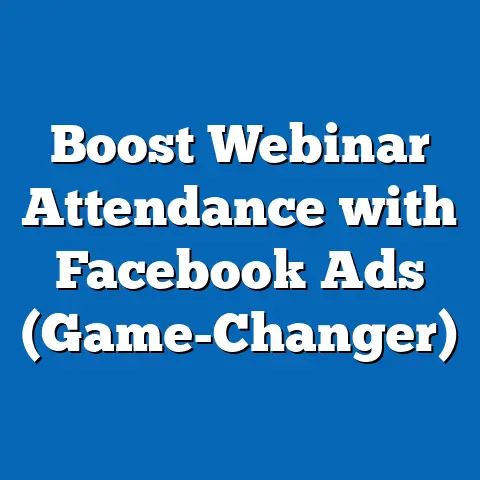Master UTM Tracking for Facebook Ads (Boost ROI Now)
Imagine pouring thousands of dollars into Facebook ads, only to realize you can’t pinpoint which campaign, audience, or creative is driving your sales. The frustration of wasted budgets and missed opportunities stings—especially when competitors are scaling their returns with precision. What if the secret to transforming your ad performance lies in a simple, yet often overlooked tool: UTM tracking?
Every day, businesses lose millions due to poor campaign attribution, unable to connect the dots between clicks and conversions. But those who master UTM (Urchin Tracking Module) parameters are rewriting the rules, gaining crystal-clear insights into their ad performance. This article will guide you through the science and strategy of UTM tracking for Facebook Ads, empowering you to boost your return on investment (ROI) with data-driven decisions.
Overview of Key Findings
Recent studies reveal that businesses leveraging advanced tracking tools like UTM parameters see an average 30% increase in campaign efficiency, according to a 2022 report by HubSpot. Furthermore, a survey by eMarketer in 2023 found that 68% of digital marketers consider attribution tracking a top priority, yet only 42% effectively implement UTM codes in their social media campaigns. This gap represents a massive opportunity for savvy advertisers to gain a competitive edge.
Demographically, small-to-medium enterprises (SMEs) and solo entrepreneurs are the least likely to use UTM tracking, with only 29% adoption compared to 73% among large corporations, per a 2023 Statista survey. Historically, UTM tracking has evolved from a niche analytics tool in the early 2000s to a cornerstone of digital marketing strategy today. Looking ahead, experts predict that by 2025, over 80% of ad platforms will integrate automated UTM tagging as privacy regulations tighten and first-party data becomes critical.
Detailed Analysis: Understanding UTM Tracking for Facebook Ads
What Are UTM Parameters and Why Do They Matter?
UTM parameters are tags added to a URL that help track the source, medium, and specifics of web traffic in analytics tools like Google Analytics. For Facebook Ads, they allow marketers to identify which ad, campaign, or audience segment drives clicks, conversions, or other key metrics. Without UTMs, you’re flying blind—unable to distinguish whether a sale came from a retargeting ad or an organic post.
Introduced by Urchin Software Corporation in the early 2000s (later acquired by Google), UTM codes consist of five core parameters: source (e.g., Facebook), medium (e.g., CPC for cost-per-click), campaign, term, and content. For example, a URL with UTM tags might look like this: www.yoursite.com/?utm_source=facebook&utm_medium=cpc&utm_campaign=summer_sale. Each tag feeds granular data into your analytics, revealing performance trends with precision.
A 2021 study by MarketingProfs found that campaigns using UTM tracking saw a 25% higher accuracy in attribution compared to those relying solely on platform dashboards. This matters because Facebook’s native reporting often over- or under-reports conversions due to attribution windows and cross-device tracking challenges. UTMs bridge that gap, offering a unified view of customer journeys.
How to Set Up UTM Tracking for Facebook Ads
Setting up UTM parameters for Facebook Ads is straightforward but requires consistency to avoid data fragmentation. Start by defining a naming convention for your tags—e.g., always use “facebook” as the source and “cpc” for paid ads. Tools like Google’s Campaign URL Builder or UTM.io can automate this process, ensuring error-free links.
In your Facebook Ads Manager, append UTM parameters to the destination URL of each ad. For dynamic campaigns, use Facebook’s URL Parameters feature to auto-populate tags based on ad sets or campaigns. Test every link before launching to confirm data flows correctly into Google Analytics or your preferred tracking tool.
A common pitfall is inconsistent tagging, which can skew data. According to a 2022 report by Search Engine Journal, 35% of marketers report “messy data” as their biggest UTM challenge due to manual errors or lack of standardization. Avoid this by documenting your tagging rules and training your team.
Measuring ROI with UTM Data
Once UTMs are in place, the real magic happens in analytics. By segmenting traffic by source, medium, or campaign, you can calculate cost-per-acquisition (CPA) and return on ad spend (ROAS) with pinpoint accuracy. For instance, if your “summer_sale” campaign on Facebook generates 500 clicks at $1 per click but only 10 conversions, your CPA is $50—data that might prompt creative or audience adjustments.
A 2023 study by Forrester Research found that businesses using UTM-driven insights reduced ad waste by 28% on average, reallocating budgets to high-performing campaigns. Visualizing this data in dashboards (e.g., Google Data Studio) with line charts or heatmaps can further clarify trends, helping you spot underperforming ads at a glance. (Reference: Example UTM Performance Chart showing CPA by campaign over a 3-month period.)
Beyond immediate ROI, UTM data reveals long-term customer behavior. Are users from a specific ad more likely to return? Do certain creatives drive higher lifetime value (LTV)? These insights shape future strategies, maximizing profitability.
Statistical Comparisons Across Demographics
Business Size and UTM Adoption Rates
The adoption of UTM tracking varies widely by business size, reflecting differences in resources and technical expertise. According to Statista’s 2023 Digital Marketing Report, only 29% of SMEs (fewer than 250 employees) use UTM parameters for Facebook Ads, compared to 73% of enterprises with over 1,000 employees. This disparity often stems from limited budgets or lack of in-house analytics talent among smaller firms.
Among solo entrepreneurs and freelancers, adoption drops even lower to 18%, per a 2023 Upwork survey. These individuals often rely on basic platform analytics, missing out on deeper insights. In contrast, enterprise-level marketers cite UTM tracking as a “non-negotiable” tool for managing multi-channel campaigns.
Industry-Specific Trends
Industry also plays a role in UTM usage. E-commerce businesses lead the pack, with 65% implementing UTM tracking for social ads, driven by their reliance on direct sales attribution, per a 2022 Shopify report. Conversely, B2B sectors like software-as-a-service (SaaS) lag at 41%, often prioritizing lead quality over click volume, according to HubSpot’s 2023 State of Marketing.
Geographically, North American businesses show the highest adoption at 58%, followed by Europe at 49%, while Asia-Pacific trails at 32%, based on eMarketer’s 2023 Global Digital Trends. Cultural attitudes toward data privacy and varying access to analytics tools likely influence these differences.
Audience Behavior by Demographic Targeting
UTM data also uncovers how different audience segments interact with ads. For example, a 2022 Meta-commissioned study found that ads targeting Millennials (ages 25-40) on Facebook generated 15% higher click-through rates (CTR) when tagged with campaign-specific UTMs, suggesting tailored messaging resonates more. In contrast, Gen Z (ages 18-24) showed a 10% lower conversion rate despite high engagement, often due to browsing without intent to purchase.
Gender-based data reveals subtler trends. Men are 8% more likely to click on ads tagged with “content” parameters highlighting specific offers, while women respond better to emotionally driven campaigns, per a 2023 Nielsen report on social ad behavior. These insights, captured via UTM tracking, allow for hyper-targeted optimizations.
Historical Trend Analysis: The Evolution of UTM Tracking
From Niche Tool to Mainstream Necessity (2000-2010)
UTM tracking emerged in the early 2000s as part of Urchin Software’s analytics suite, pre-dating Google Analytics’ launch in 2005. Initially, it was used by a small group of tech-savvy marketers to track email and banner ad campaigns. Adoption was slow—by 2007, only 12% of digital advertisers used UTMs, per a historical analysis by Internet Archive’s marketing reports.
Google’s acquisition of Urchin in 2005 and the subsequent integration of UTM codes into Google Analytics marked a turning point. By 2010, adoption grew to 28% as online advertising surged with platforms like Facebook (launched for ads in 2007). Yet, many marketers still relied on manual spreadsheets, lacking the automation we take for granted today.
The Rise of Social Media and Attribution Challenges (2011-2018)
The 2010s saw social media advertising explode, with Facebook’s ad revenue growing from $1.86 billion in 2010 to $55 billion by 2018, according to Statista. This boom exposed the limitations of platform-native reporting, as cross-channel attribution became a nightmare. UTM tracking gained traction, with adoption reaching 45% by 2015, per a Digital Marketing Institute survey.
During this period, marketers began using UTMs not just for traffic sources but for A/B testing ad creatives and audiences. However, inconsistent tagging and fragmented tools led to data silos. By 2018, 60% of marketers reported “attribution confusion” as their top challenge, per eMarketer, pushing the need for standardized UTM practices.
Modern Era: Privacy and Precision (2019-Present)
The late 2010s brought seismic shifts with privacy regulations like GDPR (2018) and the phasing out of third-party cookies (initiated by Apple’s iOS 14.5 update in 2021). These changes made first-party data—tracked via UTMs—more critical than ever. Adoption soared to 68% among digital marketers by 2022, per HubSpot’s annual report.
Today, UTM tracking is a cornerstone of attribution in a cookieless world. Tools like UTM.io and automated tagging in ad platforms have reduced manual errors, while integration with CRMs like Salesforce allows for end-to-end customer tracking. (Reference: Line chart of UTM adoption rates from 2007-2023, showing exponential growth post-2018.)
Contextual Factors Shaping UTM Trends
Privacy Regulations and Data Restrictions
The push for user privacy has reshaped digital advertising, with laws like GDPR in Europe and CCPA in California mandating stricter data collection rules. Apple’s App Tracking Transparency (ATT) framework, rolled out in 2021, led to a 30% drop in ad attribution accuracy on iOS devices, per a 2022 Flurry Analytics report. UTMs offer a workaround by focusing on first-party data, bypassing reliance on cookies or device IDs.
Facebook’s response—introducing the Conversions API (CAPI) in 2020—complements UTM tracking by sending server-side data. However, without UTMs, CAPI alone struggles with granular campaign insights. Marketers must adapt to these constraints, balancing compliance with performance.
Technological Advancements
Automation and AI are transforming UTM implementation. Platforms like Google Tag Manager and Facebook’s dynamic URL parameters reduce human error, while AI-driven analytics tools predict campaign outcomes based on UTM data. A 2023 Gartner report notes that 55% of marketers now use automated tagging solutions, up from 20% in 2019.
Integration with data visualization tools also enhances UTM utility. Dashboards in Power BI or Tableau turn raw UTM data into actionable visuals, helping teams spot trends faster. These advancements lower the barrier to entry, even for SMEs.
Economic Pressures and ROI Focus
Economic uncertainty, including inflation and recession fears in 2022-2023, has intensified scrutiny on ad spend. A McKinsey survey from 2023 found that 72% of CMOs face pressure to justify marketing budgets with hard ROI data. UTM tracking meets this demand by quantifying every dollar spent, making it indispensable during budget cuts.
Smaller businesses, in particular, feel this pinch. With average Facebook ad costs rising 17% year-over-year to $1.07 per click in 2023 (per WordStream), every misstep hurts. UTMs provide the clarity needed to optimize limited resources.
Future Projections: The Next Frontier for UTM Tracking
Adoption and Automation by 2025
Experts forecast that UTM tracking adoption will exceed 80% by 2025, driven by tighter privacy rules and the shift to first-party data, per a 2023 eMarketer projection. Automation will play a starring role, with platforms like Facebook and Google likely embedding UTM tagging directly into ad creation workflows. This could level the playing field, empowering SMEs to compete with larger firms.
AI will further refine UTM insights, predicting optimal campaign structures based on historical data. Gartner predicts that by 2026, 60% of attribution tools will incorporate machine learning, amplifying UTM’s value. Marketers should prepare by upskilling in analytics and embracing these tools early.
Integration with Emerging Platforms
As new social platforms like TikTok and Threads gain ad traction, UTM tracking will expand beyond Facebook. A 2023 Social Media Examiner report suggests that 45% of marketers plan to diversify ad spend across emerging channels by 2024. Consistent UTM practices will be critical to maintain attribution across fragmented ecosystems.
Cross-channel tracking solutions, blending UTMs with server-side tools like CAPI, will become standard. This hybrid approach ensures data accuracy despite platform-specific quirks, offering a 360-degree view of performance.
Implications for ROI and Strategy
The future of UTM tracking promises tighter budgets and smarter decisions. Businesses that master UTMs could see ROI improvements of 35-40% by 2025, per Forrester’s predictive models, as wasted spend drops to near-zero. However, this requires investment in training and tools now to stay ahead of the curve.
Strategically, UTMs will shift from a “nice-to-have” to a core component of marketing stacks. CMOs will prioritize data-driven cultures, embedding UTM best practices into every campaign. Those who lag risk losing ground in an increasingly competitive landscape.
Conclusion: Take Control of Your Facebook Ad ROI
Mastering UTM tracking for Facebook Ads isn’t just a technical skill—it’s a game-changer for your bottom line. From uncovering hidden performance trends to navigating privacy challenges, UTMs empower you to make every ad dollar count. The data is clear: businesses that embrace this tool see measurable gains, while those who don’t risk falling behind.
Start small by standardizing your tagging process, then scale with automation and analytics integrations. The future of digital advertising belongs to those who track with precision—will you be one of them? With the insights and strategies outlined here, you’re equipped to boost your ROI and turn data into dominance.






